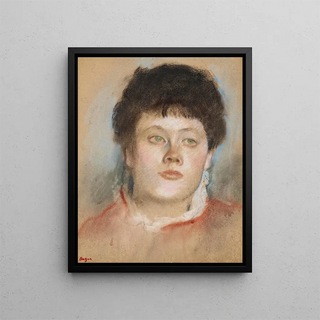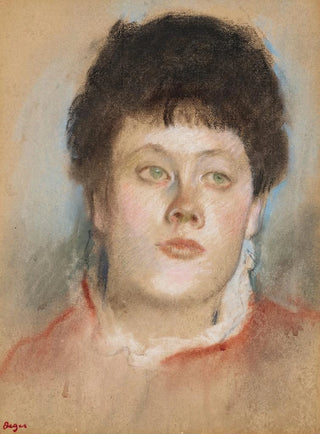Painting Portrait of a Woman - Edgar Degas | Art print


View from behind

Frame (optional)
The "Portrait of a woman" by Edgar Degas is a work that transcends time and space, capturing the very essence of femininity through the lens of Impressionism. This painting, created at the end of the 19th century, offers a fascinating glimpse into human psychology, blending intimacy and observation. The artwork depicts a woman in a pose that is both natural and contemplative, evoking an emotional depth that invites reflection. The soft light bathing the woman's face enhances this impression of delicacy and mystery, making this piece a true masterpiece.
Style and uniqueness of the work
Edgar Degas's style is distinguished by his innovative approach to composition and color. In the "Portrait of a woman," he employs fluid brushstrokes and subtle color nuances to bring his subject to life. The pastel technique, which he particularly favors, allows for the creation of rich textures and striking contrasts, emphasizing the natural beauty of the depicted woman. Degas also plays with light and shadow, creating an intimate atmosphere that seems to capture a fleeting moment. This work is emblematic of his talent for immortalizing everyday life and exploring the complexity of human emotions, making each glance at the painting a unique experience.
The artist and his influence
Edgar Degas, an iconic figure of the Impressionist movement, established himself through his sharp eye on modern life. Born in 1834, he evolved in a vibrant artistic environment, where he mingled with masters such as Monet and Renoir. However, unlike his contemporaries, Degas often favored less sunny subjects, exploring urban life and ballet scenes. His technical approach, blending realism and abstraction, profoundly influenced the development of modern art. The "Portrait of a woman" fits within this lineage, demonstrating his skill in capturing the essence of his models while placing them within a broader context of reflection on the human condition. Degas thus paved the way for many generations of artists, who continue to explore themes of femininity and everyday life.

Matte finish

View from behind

Frame (optional)
The "Portrait of a woman" by Edgar Degas is a work that transcends time and space, capturing the very essence of femininity through the lens of Impressionism. This painting, created at the end of the 19th century, offers a fascinating glimpse into human psychology, blending intimacy and observation. The artwork depicts a woman in a pose that is both natural and contemplative, evoking an emotional depth that invites reflection. The soft light bathing the woman's face enhances this impression of delicacy and mystery, making this piece a true masterpiece.
Style and uniqueness of the work
Edgar Degas's style is distinguished by his innovative approach to composition and color. In the "Portrait of a woman," he employs fluid brushstrokes and subtle color nuances to bring his subject to life. The pastel technique, which he particularly favors, allows for the creation of rich textures and striking contrasts, emphasizing the natural beauty of the depicted woman. Degas also plays with light and shadow, creating an intimate atmosphere that seems to capture a fleeting moment. This work is emblematic of his talent for immortalizing everyday life and exploring the complexity of human emotions, making each glance at the painting a unique experience.
The artist and his influence
Edgar Degas, an iconic figure of the Impressionist movement, established himself through his sharp eye on modern life. Born in 1834, he evolved in a vibrant artistic environment, where he mingled with masters such as Monet and Renoir. However, unlike his contemporaries, Degas often favored less sunny subjects, exploring urban life and ballet scenes. His technical approach, blending realism and abstraction, profoundly influenced the development of modern art. The "Portrait of a woman" fits within this lineage, demonstrating his skill in capturing the essence of his models while placing them within a broader context of reflection on the human condition. Degas thus paved the way for many generations of artists, who continue to explore themes of femininity and everyday life.
12,34 €






